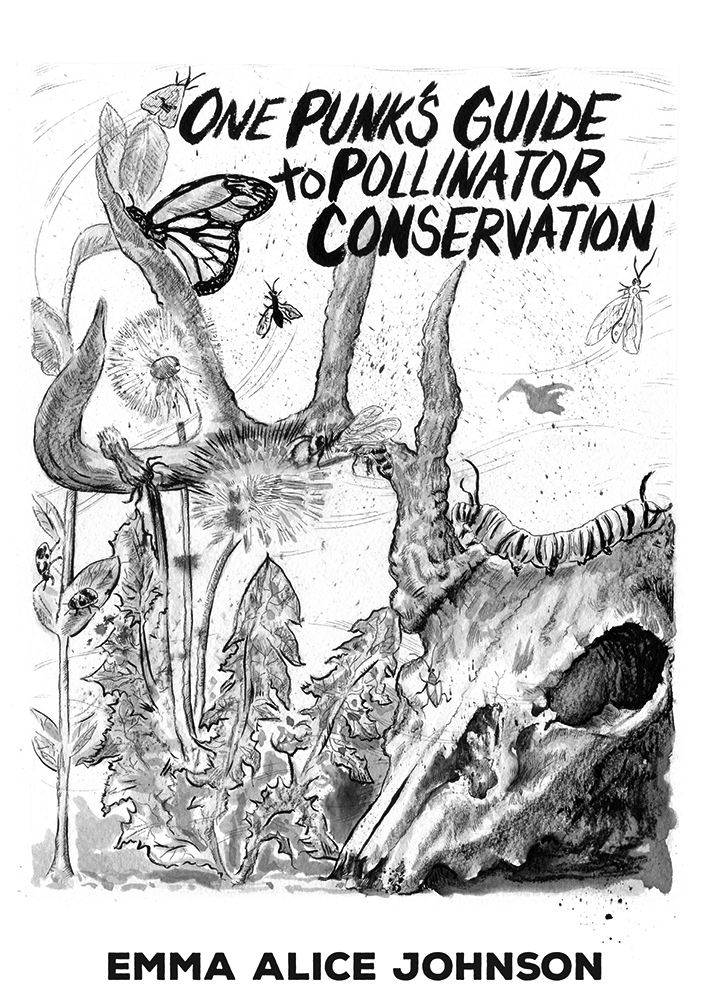
One Punk’s Guide to Pollinator Conservation By Emma Alice Johnson
Originally ran in Razorcake #134 (June/July 2023)
A current runs through poems and memoirs of people finding nature after experiencing trauma. That’s what happened to me a few years ago. Heck, that’s what happened to a lot of us at the start of the pandemic, if the boom in seed sales is any indication. But I also experienced a more acute trauma around the same time, and it hit me so hard it knocked me out of my self, out of my whole life, and left me rolling around screaming until out of desperation I grabbed onto the earth, stuck my hands in the dirt, and held on until I found a new me. That new me is inextricably linked with nature, with the plants and creatures who surround me every day that somehow, in the process of growing up, I had forgotten how to see.
As a kid, I saw them. I’d chase beetles and hold somber funerals for the grasshoppers who passed away in my care (’80s kids: remember that bone candy that came in tiny plastic coffins? Perfect for grasshopper interment). On early summer days, my grandpa and I would go to the Milkweed patch to look for Monarch butterfly caterpillars. The Milkweed patch was just a ditch along Clairemont Avenue, but to me it was a glimmering emerald forest of wonder with stalks of common Milkweed nearly as tall as me. We would catch caterpillars and bring them back to my grandpa’s house, where we built elaborate cages for them in his workshop. Together, we watched the caterpillars grow until they retreated into their chrysalises. When they emerged as butterflies, we released them, waving goodbye and wishing them well as they disappeared into the summer sky.
I reconnected with that little girl running through the Milkweed patch with her grandpa and decided I could continue on that path, I could love bugs again and, perhaps, even do some small work to keep them safe. So I read everything about insect conservation I could get my hands on. I observed. I begged my friends to let me tear up their yards and install pollinator gardens. I said goodbye to my Minneapolis apartment life and found a farm built on the remains of a ghost town in middle-of-nowhere Wisconsin. I began doing everything possible to create the habitat endangered insects need to hopefully stick around a little while longer.
I despair at the thought there will be a summer day in my lifetime when I walk outside and don’t see a butterfly fluttering around me, but that seems likely at the rate species like the Monarch are disappearing. That doesn’t mean we shouldn’t try, though. In my short time doing this work, I’ve learned that protecting insects is something everyone can do with minimal impact to their lifestyles. Regardless of whether you live in a tiny apartment in Los Angeles or a massive farm in Wisconsin, there’s something you can do that will help keep insects safe.
I’m going to use the word “insect” in the general, most inclusive sense, rather than the scientific sense. I’ll use the word “bug” interchangeably, though they’re different. I’m also going to use the most-familiar-to-me common names for insects and plants. My experience is limited to working in the upper Midwest of the United States, so everything I discuss will be coming through that lens. Plant and insect species vary dramatically throughout the U.S. and worldwide. Some of the practices or methods I suggest may not work in every ecosystem, but should serve as a solid starting point.
Full disclosure, I’m still a newbie. I’m currently planning for my fourth growing season at the farm, where my focus is a five-acre field I’ve planted with native grasses and flowers, as well as several small gardens. I’ve also installed, assisted with, or provided guidance on a couple dozen backyard pollinator gardens of various types and sizes, most of which are still thriving. There are people far smarter than I out there doing this work, but some of the messaging can be contradictory, inaccessible, and impractical. This guide is for newcomers and pros alike, folks with all budgets and spaces, who want to protect our insect buddies.




